Spiel 2021
So far, this blog has been a cocktail blog, but my plan has always been to post about anything I find interesting, which is mostly pretty stereotypical of a nerd living in San Francisco and working in tech, but certainly not limited to just booze. Today I’m going to broaden the blog’s horizons by writing about my recent trip to Spiel 2021 in Essen, Germany, where I got to try 19 different new board games, 7 of which made it home with me:
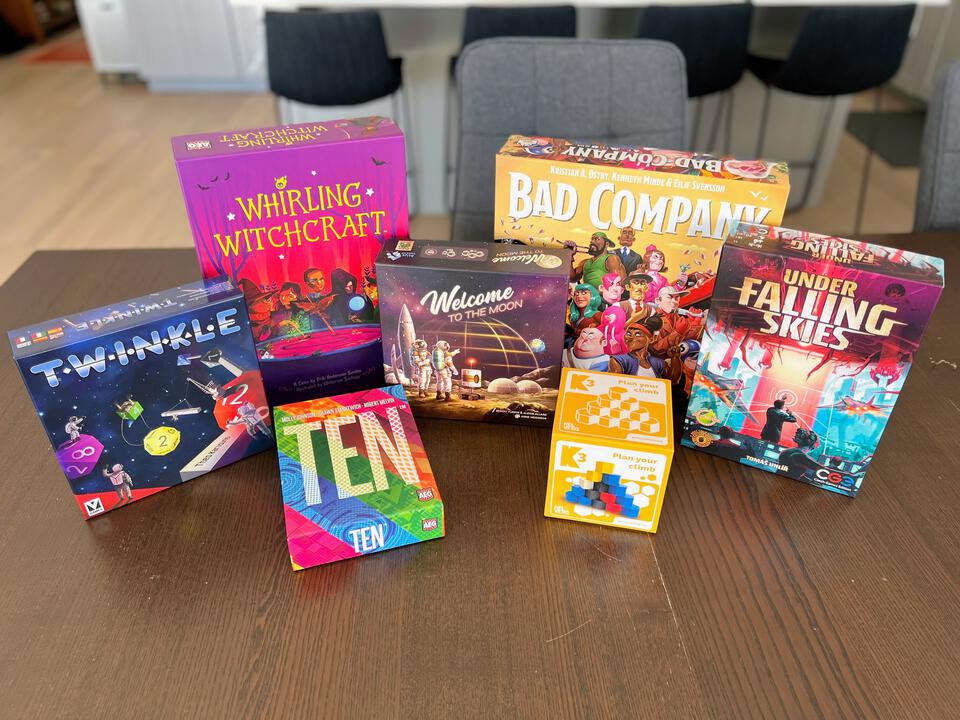
Every year (except for last year), Essen holds the world’s biggest board game fair. In 2019, the turnstile attendance count was over 200,000 people across the 4 days of the conference. Hundreds of new board games are released every year by hundreds of different publishers. At the publishers' booths, you can sit down at a table, have someone explain the rules of the game to you, and then let you play a full game (rarely, they’ll cut you off mid-way, but I’ve played a full 3-hour game before). Spiel is such a big deal in the board gaming world that Essen will show up on board game maps, even though it’s only the 9th largest city in Germany. (Go check your Pandemic map—Essen is on there, but Berlin is not)
I went to Spiel for the first time in 2017 and was completely hooked; I’ve been to every Spiel since. When they announced that the fair was happening this year, I was apprehensive but excited. I started planning my trip in earnest in July, but I carefully avoided anything non-refundable until maybe the week before the trip, since I felt like the state of the world was too unpredictable to make firm commitments. As some publishers (including Asmodee, who usually have the largest footprint of any publisher at the show) announced that they wouldn’t be attending, I worried that Spiel wouldn’t be worth attending.
In August, Spiel announced their safety policies: attendance would be limited to 30,000 visitors per day (final turnstile count was 93.6k over four days); everyone in Messe would need to be vaccinated, recovered, or tested (Germany’s “3G rule”); and masks would be required indoors at all times. As a small bonus, a local pharmacy converted non-EU residents' vaccination records to an EU Digital COVID Certificate, so I can now easily demonstrate my vaccinated status to any EU member state. I expect that to be valuable for any travel I do in the future. Ultimately, falling cases in both the US and Germany, attendance from many though not all major publishers, and the robust safety policies convinced me that Spiel was worth attending.
And honestly? Even surrounded by 30,000 people, I felt safer at Spiel than I’ve felt at some places in America. The halls at Messe are giant, open, well-ventilated spaces, and the 3G checks at the door were rigorous. Many people commented about how unhappy they were that the state of the world necessitated masks, and it was occasionally hard to hear explanations, but despite that, mask compliance among all attendees was outstanding. I am truly grateful to Spiel for managing to organize the show given the uncertainty in the world and to everyone attending for their commitment to our collective safety.
But onto the games! Over the weekend, I played 18 different games (and bought one game I didn’t have a chance to play)—fewer than I’ve played in past years, but I’ve gotten better at picking games I’m likely to enjoy, rather than just sitting down at any open table I see. Those weren’t all complete playthroughs, but enough to feel like I had a good grasp on the basics of the game.
I did tweet many of these reviews while I was in Germany, but I’ve expanded on them here and added a few more that I didn’t cover on Twitter. Here’s the list—click on any of them to jump to the writeup (💸 indicates games that I bought):
- Ark Nova
- Azul: Queen’s Garden
- 💸 Bad Company
- Chinchiller Dice
- Endangered
- Galaxy Trucker
- Genotype
- If It Fits
- 💸 K3
- Last Message
- LUNA Capital
- Rush Out!
- The Siege of Runedar
- 💸 TEN
- Tiny Acrobats
- 💸 Twinkle
- 💸 Under Falling Skies
- 💸 Welcome to the Moon
- 💸 Whirling Witchcraft
Ark Nova
This might have been the buzziest game at Spiel this year. Allegedly there were only 20 non-preorder copies of the game, which disappeared instantaneously, but they ran demos all weekend. I managed to grab a seat at a table for the last demo on Friday.

Photo by Michael Wißner
Ark Nova is Sim Zoo: The Board Game. You’re trying to build a zoo full of animals that appeals to people and makes money, while also contributing to conservation efforts. Appeal and conservation score on the same track, but from opposite ends moving towards the center. When they cross, the game ends. The game is rated to take up to 2½ hours, but we only played for about 45 minutes or so.
At the time, BoardGameGeek rated this as a 4.15/5 for complexity, about as complex as Twilight Imperium or Through the Ages (it’s since dropped to a more manageable Agricola-tier 3.67), so I assumed it would be heavier than I’d enjoy. The game does have a lot of mechanisms: a tile placement puzzle (laying out your zoo), a worker placement mechanism (coordinating your zoo’s interactions with the greater zoological community), multiple independent scoring mechanisms (appeal and conservation), actions that get more powerful the less frequently you use them, an upkeep phase that occurs at unpredictable times…it’s a lot.
For the demo, they had preset starting hands for each player with cards that were designed to synergize with each other. One person had cards that favored a zoo full of predators, another a zoo full of birds. My hand favored reptiles. What a great idea! With Euro-style games where there are different ways to score, it’s often hard to tell what direction to build your engine without a preexisting understanding of the game. By stacking our hands, we got a taste of what it’s like when you know enough to play effectively, and it made all of the mechanisms feel manageable. I wish more demos did this.
I liked Ark Nova, and at some point, I’d enjoy playing through a complete game. I think the assortment of mechanics mostly fits together well and gives you some variety in what you do from turn to turn. However, I have a hard time getting a group together to play any 2+ hour game, so I’ve become reluctant to buy new ones. Buying this one is probably not for me, but I’d be happy to join a group that was going to play it.
Azul: Queen’s Garden
Ahem, I knew about Azul before it was cool 😎. The first Azul was released at my first Spiel in 2017. Coming from a designer with a history of only moderately popular games and a publisher with only a few games under their belt, Azul didn’t make most of the lists of anticipated games going into the fair, and it was really discovered at the fair. Azul is a great game, probably the best gateway game to come out in the last 5 years.
Plan B has released a new Azul game at every Spiel since: Stained Glass of Sintra, Summer Pavilion, and this year, Queen’s Garden. All of them come with similar chunky and satisfying tiles and build on the basic tile drafting and set collection mechanics of the original, but with new locations and new rules. Each game has gotten slightly more heavyweight than the game before it.
Ever since it was released, Azul has been very popular at Spiel, and getting a table to play the demo has been challenging. This year, Plan B had a queue of people snaking around their booth waiting to play Queen’s Garden. (They might have been there to play Plan B’s other big releases of the year—the 2nd edition of Great Western Trail and the new Off Season expansion to Camel Up, but my guess is they were there to play Azul) I rushed the booth at the beginning of the second day and managed to sneak my way onto a table…of German speakers 😬. Major thanks to Viktor of the Plan B team who basically gave me my own personal live translation of the rules explanation.
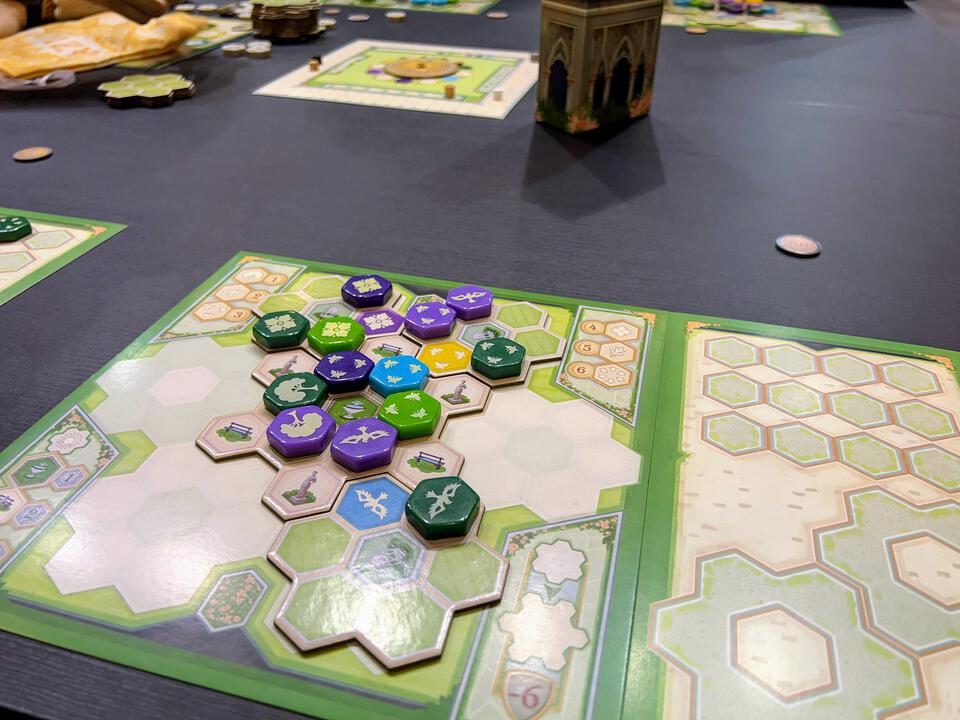
My (winning) board at the end of my demo game of Azul: Queen’s Garden
Queen’s Garden felt like the heaviest Azul game yet, and it felt like there was more puzzling and long-term strategy to managing your own resources. The tile placement and adjacency mechanics were more complex than I remember for past Azul games, and I found them difficult to keep track of. I really didn’t like the use of color in this game, though—the light purple and dark purple were very hard to distinguish from each other, even in the bright lights of the Messe, and light green and dark green weren’t much better.
For me, the original Azul is still the best Azul. I would probably play this again given the opportunity, but I don’t know that I could recommend it unless you feel like you’ve plumbed the depths of the original game and are looking for something newer and more think-y.
💸 Bad Company
In Bad Company, you train a gang of criminals and pull off heists. I was intrigued purely based on theming, because I love a good heist anything (movie, book, game, you name it). This game was popular going into Spiel and remained popular through the weekend. Coming from a smaller publisher with a smaller booth and only two demo tables of the game setup, this one was hard to get a seat for. I was walking by the booth late on Friday when I heard “and now for your final turn…” and stopped in my tracks. I’m glad I did!
This game felt kind of like playing Craps to me, which I guess is sort of thematically appropriate? You have 9 crew members, each assigned a number between 3 and 11. On your turn, you roll 4 dice and pick how to combine them into two pairs. Each of those pairs corresponds to one of your gang members, and those gang members give you some sort of action (unlocking a safe or driving the getaway car, etc.). But every other player gets to choose one (not both) of the pairs of dice and activate one of their gang members. Even when it’s not your turn, you still have something to do.
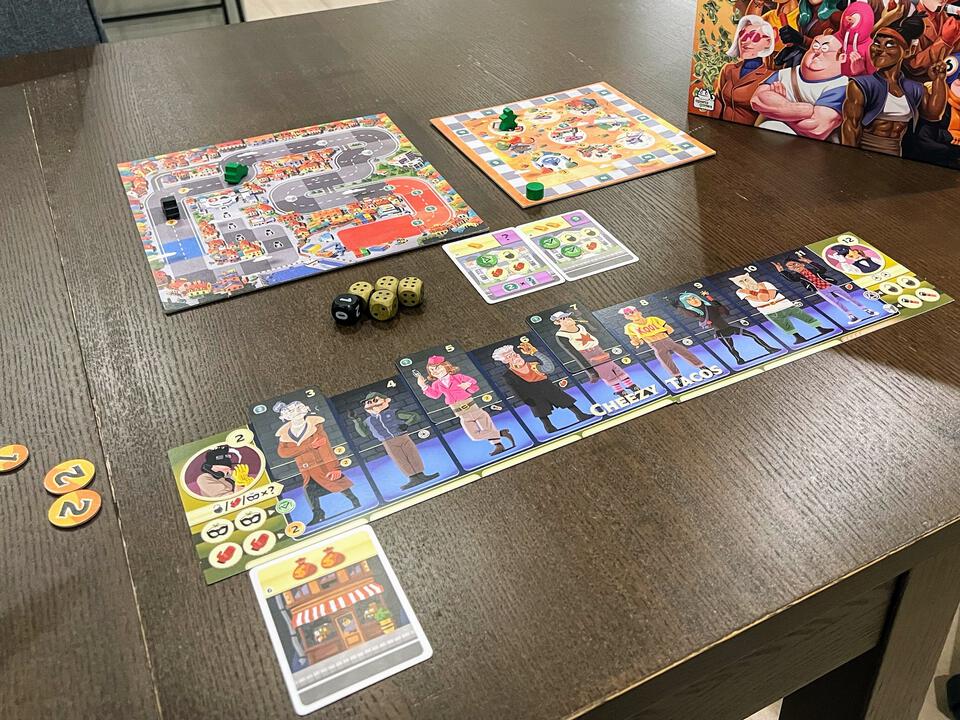
Some of the components of Bad Company. One of the zanier things is that as you upgrade your “gang,” they get taller and lankier 🤣
During the game, you complete heists, collect loot (one-time bonus effects), acquire necklaces (for being the best at a particular type of heist), upgrade your gang, and outrun the cops. That’s probably my biggest complaint about this game: there are a lot of different things happening that don’t always feel like they’re exceptionally well related to each other. But despite that, I did find it enjoyable to play. The artwork is fun—the gang members have a sort of zany, Carmen Sandiego vibe to them.
This probably isn’t a perfect game, but I’m always interested in ways to minimize player downtime, and I found the mechanics of individual turns to be fun and engaging. I ended up buying this game to bring home with me, and am looking forward to trying it with friends.
Chinchiller Dice
Chinchiller Dice has a super on-point pitch (“literal blind trust”) that had me excited to try it. In the game, you roll dice to accumulate resources (“sand”). But if you roll two chinchillas, you have to close one eye. Once both eyes are closed, your neighbor rolls for you and tells you what you rolled. You get to decide if they’re telling the truth.
This game is quick, has a fun but casual bluffing mechanic, and comes with a cute, lighthearted theme. However, I found the rules to be just a little too complicated for the form factor of the game. The rules for eyes open vs. eyes closed are presented as fundamentally the same, but paper over a significant mode switch in how the game works that I found jarring. And as a minor thing, the currency tokens have convoluted values (1, 6, 24) that I found hard to keep track of.
(Also, the rules suggest playing multiple games with different starting players, which undercuts the quick advertised playtime.)
I love the idea of this game, and I would enjoy a similar game with rules that felt a bit more cleaned up, but this particular one wasn’t for me.
Endangered
In Endangered, you play cooperatively as a group of conservationists trying to save an endangered species (in the base game, that’s either tigers or sea otters; expansions add sea turtles, polar bears, California condors, elephants, pupfish, jaguars, tapirs, and pandas). Your task is to convince UN ambassadors to vote for a resolution protecting the species before the species goes extinct. Each role has slightly different player powers (e.g. the zoologist might be good at relocating animals away from pollution and deforestation, while the philanthropist might print money).
This game had some nifty mechanics around dice worker placement. At the start of your turn, you roll your three dice and place them on actions you want to take. But there’s a catch: your die’s value must be strictly higher than any dice already present on an action, and dice aren’t picked back up until that player’s next turn. That means that if you place a 6 on an action, that action is effectively locked out for a round. Additionally, turn order within a round is variable (each player goes once per round, but it can be in any order). As a result, there’s a fair amount of neat puzzling how to optimize actions, manage bad dice rolls, and get the most done.
But while I enjoyed the mechanics, the theme didn’t work for me. There was just a little too much realism in the setup, and it felt a little too much like a morality lesson. I think that there’s validity to that, and I do believe in games as a way to teach things. But I pick board games that can be more of an escape—the real world is bad enough without encroaching on leisure activities.
(I did ruminate for a while on why I had that reaction to this game, but not to Ark Nova, which has a similar thread of environmentalism and conservationism. I think the answer is that in Ark Nova, it’s more of a background thread, rather than the dominating theme of the game.)
I did find the game to be reasonably good, so while this one wasn’t for me, if you’re not bothered by games that are also trying to make a statement, you might enjoy this one.
Galaxy Trucker
This game comes from Czech Games Edition and is a re-release of a game originally from 2007. I always enjoy trying CGE’s lighter games—they’re most broadly known for Codenames, and they frequently have a similarly light release they’re trying out. I thought that Trapwords had a particularly fun Taboo-esque mechanic.
In Galaxy Trucker, you build a spaceship from scrap components and then try to successfully collect and deliver cargo while your spaceship falls apart around you. I never played the original and was eager to try it, but after a handful of times circling the CGE booth and looking for a table to open up, I eventually gave up on trying a cardboard version. Instead, I sat down to try their digital tablet version of the game. So while I technically played a complete game, it was in tutorial mode and against an AI that wasn’t trying very hard. (The lack of pressure from other players is probably the only reason I had a functioning spaceship)
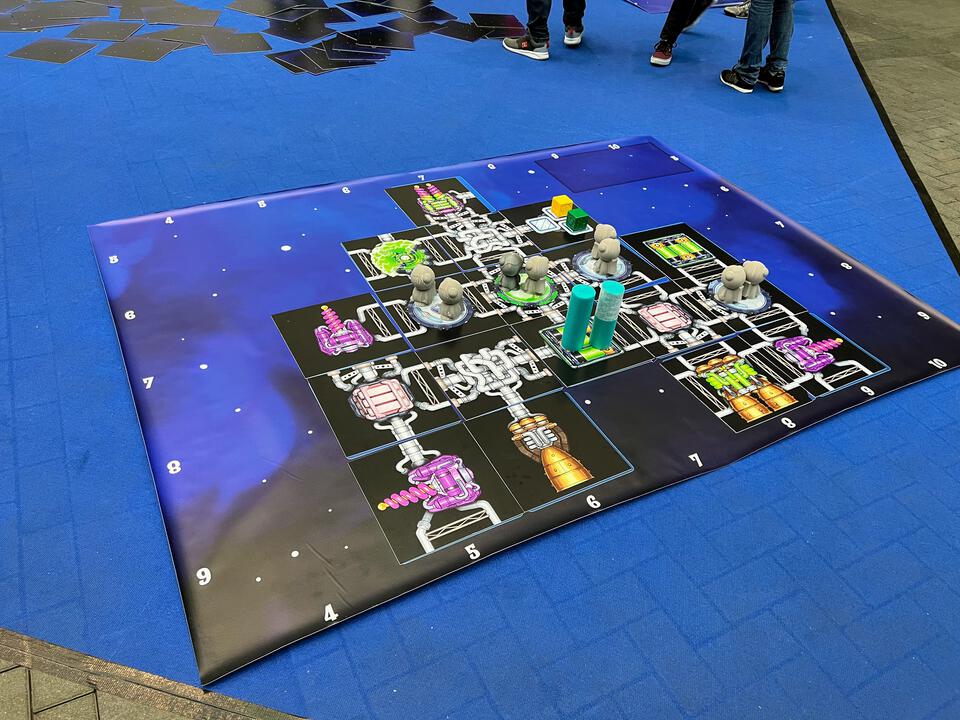
In addition to normal-sized demos at the CGE booth, there was also this giant edition in the open gallery that seemed to be primarily for the benefit of children. Giant promotional editions of games are one of my favorite things about these fairs.
Playing the tablet version did make me want to try the cardboard version. The game is zany and colorful and chaotic. At the time, I thought that the digital version was iPad-only, but now that I’m writing this, I actually see that there are both iPad and iPhone editions, so I’m going to go pick that up. I guess that makes this a ½💸?
Genotype
Genius Games specializes in educational games about science and math. They have games about cell biology, atomic structure, mathematical programming, and more. I’ve played Lovelace & Babbage in the past and found it reasonably enjoyable, although I don’t know that I learned all that much about the analytical engine—it’s sort of like the numbers round in Countdown. Genotype is a worker-placement game where you’re trying to breed pea plants with specific characteristics by selecting the genetics of the parent plants.
The mechanics around breeding are kind of nifty. Each trait has a Punnett square on the edge of the board, and on each round, you roll dice with values 1-4 to simulate breeding the two parents on the outside of the Punnett square. Each die value represents a different combination of parent genes. One of the worker placement options lets you change the parent plants, thus changing the outside of the Punnett square and thus changing the probabilities of getting a particular trait.
I will caveat this by saying that we only played a partial game (3 out of 5 rounds), but as with Lovelace & Babbage, I didn’t feel like the game taught me a lot about the underlying science. (Both games come with a booklet that specifically teaches the science, which I of course did not read.) Some of that was, I think, in the explanation of the rules, which focused on the mechanics of the game (“swap this tile”) rather than the semantics (“replace this parent plant with this other parent plant”). It also felt like there were just a lot of mechanisms—in addition to the main plant breeding mechanic, there’s an upgrade marketplace and several different ways to earn bonus points at the end of the game.
For the demo table, they set up the upgraded components, which included some nice metal coins and printed wooden pieces. They were nice and definitely added to the game beyond standard cardboard. Overall, though, I felt like I couldn’t connect the gameplay back to the science that it tries to teach, so it was hard to evaluate it as more than just a worker placement game, and as a pure game, I didn’t feel like it was anything special.
If It Fits
A board game built on the “if it fits, I sits” meme, If It Fits has you putting cats in cardboard boxes. I wanted to try this one because it seemed like the theme could be entertaining, but I found it a bit lacking.
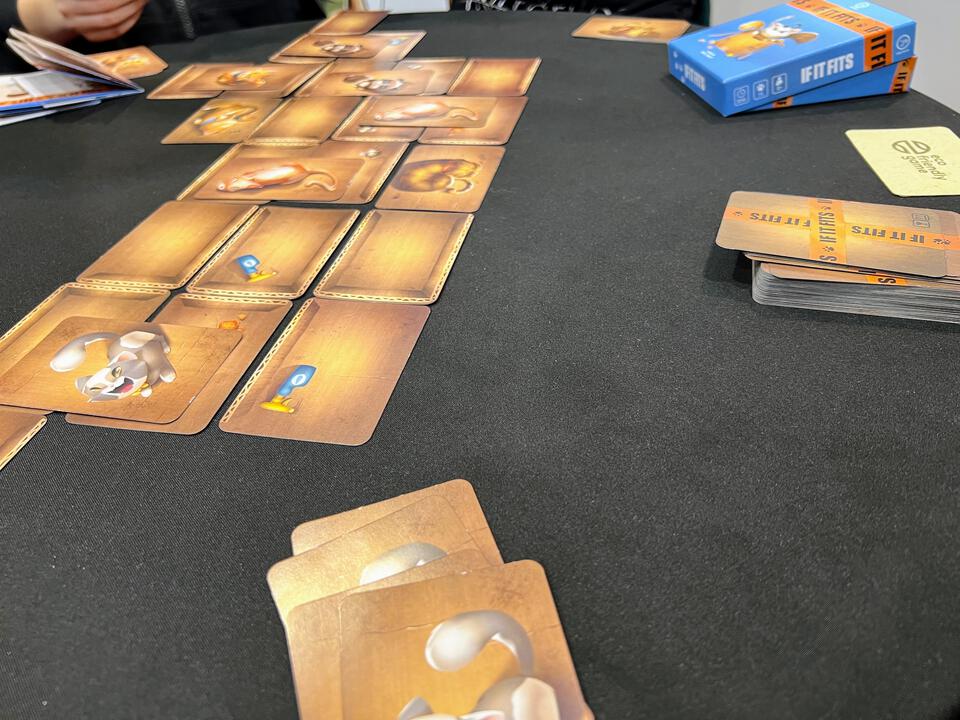
The artwork was appropriate, I guess, although certainly not the cuteness overload that this game needed (each player has a different cat, but all of your cat cards were the same art, which seems like a missed opportunity). What bothered me more, though, was the rules, which felt recognizably Carcassonne-derived to me. The gist is that cats are meeples, and cardboard boxes are cities. It’s not identical—you don’t score points for box (city) area, but there is something very similar to the shields, and the area control mechanics are quite similar (e.g. building two boxes and joining them together to take over the mega-box).
I was pretty disappointed by the unoriginality of the rules, and given that, I maybe went into the demo game a bit biased, but I didn’t find anything especially inspiring in the gameplay. After a few rounds, there were relatively few options for card placement, and the cards are big enough that it felt like a bit of a space hog on the small demo table at Spiel. I’m not sure who I could recommend this game to; I felt like it was just a little flat overall.
💸 K3
Before going to Spiel, I put K3 on my list of interesting games. Some things appealed to me without playing the game: a quick and lighter-weight abstract strategy game with high-quality components and a simple rules explanation. I was eager to try it out, but unfortunately, the publisher, Helvetiq, had a very limited demo setup at their booth (which was pretty cozy). So when I was buying games, I decided to take a chance and pick it up without playing a demo first.

K3 plays either as a competitive or cooperative game, with 2-4 players. In either case, you start with a row of hexagonal tiles in the middle of the table. To set up the game, each player drafts a set of tiles and uses them to build a pyramid in front of them. Then, players take turns placing tiles from their pyramid onto the row in the middle (representing the mountain K3). Tiles must be on top of a tile of the same color (unpainted tiles are wildcards). In the competitive game, you lose if you can’t place a tile legally; the winner is the last player standing. In the cooperative game, your goal is to complete the top of the pyramid (you’ll have a couple of tiles leftover).
I tried K3 once I got home from Spiel, and so far I quite like it! There’s definitely strategy—especially in how you draft and build your pyramid of tiles—but the game sets up and plays quickly (the box says 30 minutes; both of my two-player games were less than 20). It strikes a good balance for me of having meaty strategic decisions without encouraging deep planning ahead. I’ll definitely pull this out as a warmup game for small groups in the future.
Last Message
A crime has been committed! Fortunately, the victim can send limited messages back to the detectives investigating the case, but the criminal gets one last pass at the information.
Last Message is an asymmetric two-sided, all-against-one party game with a Captain Sonar-style screen divider between two teams. On each side of the divider is a busy Where’s Waldo-style graphic. On one side sit the victim and the criminal; the (1 or more) detectives sit on the other side.

The word in the top-left was originally “PINK,” but half of it got erased
The criminal chooses a character from the graphic, and the victim attempts to communicate that character to the detectives with a series of dry-erase drawings. However, before they pass the drawing to the detectives, the criminal gets to erase some of the segments. For the first round, they get to erase 5 out of 9, then fewer each subsequent round. In each round, the detectives get to make a guess. If the detectives are unable to guess after 4 rounds, the criminal wins; if the detectives find the criminal, then they and the victim win.
I played two games, one as a detective and one as the criminal. I found it fun, although not something I was in any rush to play again. I worry that it’s a little too easy for the team since over 4 rounds there’s just a lot of information that the victim can pass through to the detectives, but that could probably be fixed with some house rules. (Even as the criminal, I really tried to limit the amount of new information that was shared with each drawing and wasn’t able to win) Overall, I don’t think this is a blockbuster, but if you’re looking for a new party game and like Where’s Waldo or other books in that format, you might find this enjoyable.
LUNA Capital
LUNA Capital was definitely one of the hotter releases at Spiel this year, and it seemed to stay hot throughout the weekend. You’re claiming land on the moon and developing it into a settlement. It’s a sort of double-layered tile drafting and placement game. There are 12 rounds in total, divided into three phases. On your turn, you chose a card and some number of tiles (one tile in the first round of a phase, then increasing up to four tiles before resetting back to one tile again). Both are dealt out randomly, but you have to take the card and tiles from the same column.
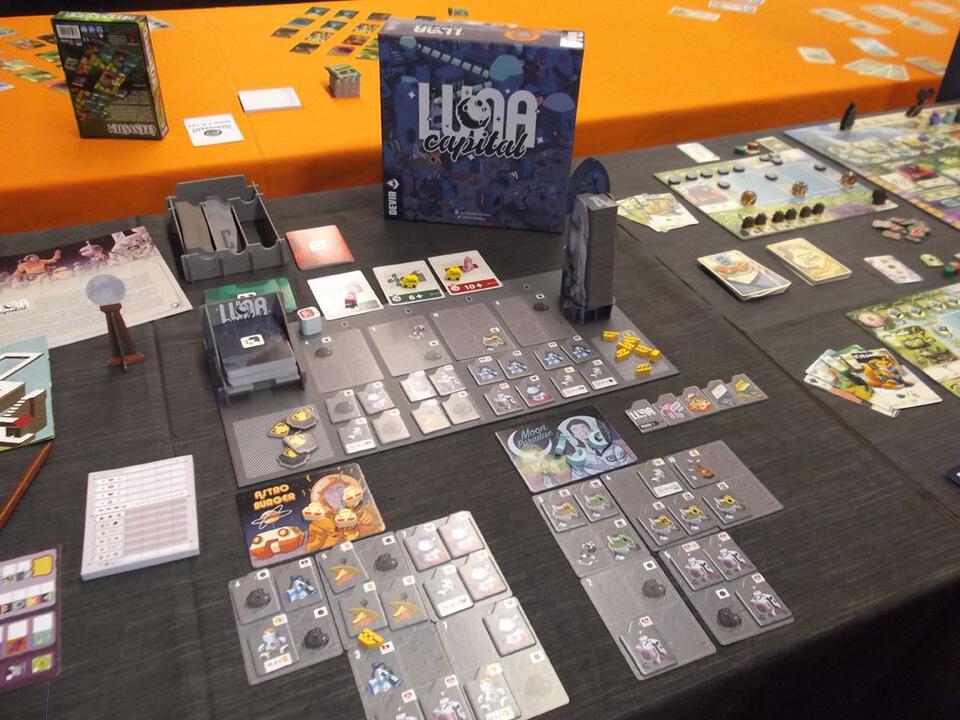
Photo by André Heines
The cards represent land on the moon, and you place those first, followed by the tiles (which don’t have to go on the card you just placed). Cards have a number in the corner, and they have to be placed such that the numbers increase from left to right, but you can have up to three rows of cards. Tile placement is mostly unconstrained. At the end of the game, you have 12 cards and 30 tiles placed on your settlement; then you get to score.
LUNA Capital is a point salad game—a game where there are many different ways to score points. If you’ve ever played 7 Wonders, you probably recognize the descriptor (or you can enjoy this thread of board gaming pedantry on the topic). There are 10 different ways to score points, mostly based on having similar tiles adjacent to each other. I don’t necessarily hate point salad games, but generally, I want the gameplay itself to be fun in some way (e.g. I think Altiplano is a bit of a point salad, but the bag building makes it fun), and the tile-laying in LUNA Capital didn’t really grab me. However, the dual-layered placement is a bit unique, the artwork is cute, and the gameplay is quick. This game wasn’t for me, but I certainly don’t think it’s a bad game.
Rush Out!
Rush Out! is a fast-paced, real-time, asymmetric game from Sit Down!, which appealed to me, because they published my favorite fast-paced, real-time, asymmetric game: Magic Maze. I put Rush Out! fairly high on my list of interesting games in the hopes that it would have some of the same magic that Magic Maze did, and it ended up being the first game at Spiel I sat down to play.
The game is an all-against-one game, where a group of heroes attempts to escape from an evil sorcerer by rolling dice as quickly as they can. Each team is trying to work through a deck of cards first. Each card has a collection of symbols, and when you roll that symbol, you can place a die on it. Once all of the symbols have been filled, you clear that card and move on. While the team of heroes can work together, the evil sorcerer’s cards have negative effects on the heroes' progress when they’re completed.
Games are snappy (I don’t think ours took more than 10 minutes) and chaotic, but ultimately this game didn’t really grip me. While there was some coordination with my teammate, I mostly felt focused on rolling my own dice as quickly as possible and didn’t feel much of a sense of engagement. For someone looking for a game that’s fast-paced and real-time, I’d recommend Magic Maze. Magic Maze is, for the record, purely cooperative instead of all-against-one, but I think that’s an improvement. It also has a much more engaging set of rules and better (though hilariously limited!) player interaction.
The Siege of Runedar
Oh my, this game is a showpiece. The Siege of Runedar was hot going into Spiel for two reasons: (a) it was designed by Reiner Knizia (probably most broadly known for Tigris & Euphrates, but has a long catalog of games and a lot of enthusiastic fans) (b) it’s a crazy tower defense game where the bottom of the game box is the tower. I mean, just look at this thing:
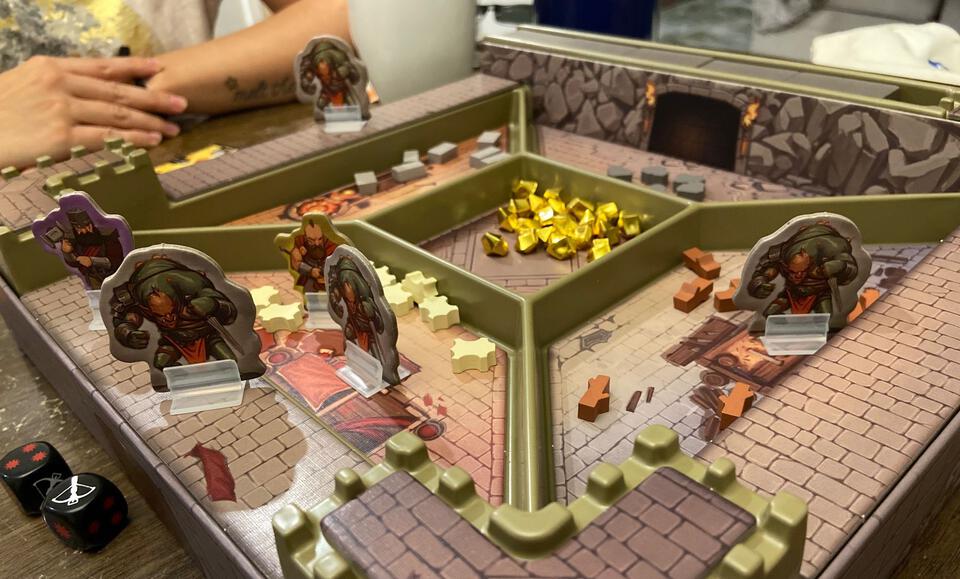
Photo by W. Eric Martin.
That’s the box that the game comes in!
In The Siege of Runedar, your dwarf mines are being attacked by orcs, and you must dig a tunnel and smuggle the gold out before the orcs can overwhelm you. Mechanically, it’s a deck builder, or really, a “deck upgrader,” since you’re limited to 12 cards. But as you upgrade cards, you get stronger weapons and better capabilities.
The buzz around the game seemed to carry itself through the stock at Spiel—the publisher Ludanova ran out of copies before the end of Saturday (maybe end of Friday, I don’t remember for sure). And with a small booth and only one or two demo tables, it was hard to get a seat. I wasn’t able to play a full demo game; instead, I subbed in midway through for another player that stepped away, and only got to play a few rounds after that.
Given my limited playtime, I don’t have a fully-formed opinion on The Siege of Runedar yet. The gameplay felt challenging, but I didn’t really know what I was doing. It’s definitely an expensive game (€50 at Spiel; no idea what it will sell for in the US), and I don’t think I’m likely to buy it without more experience. However, I will say this: using the box as the tower is such a neat concept, and I think it looks amazing. Every time I walked past the booth and saw the game set out it made me smile. I’d love to try this game again at some point…just maybe not with my own copy.
💸 TEN
I picked out TEN in advance of Spiel because it looked like a fun, quick card game. I’m always in the market for something in that category, especially if it travels well (something like Red 7 is my archetype of this category—unique rules, fun and quick to play, super portable). While that’s not quite the category it fits into (there are some tokens in addition to the cards, so it’s not quite as portable), I still found it to be enjoyable.
TEN comes with a deck of cards with numbers from 1-9 in four different-colored suits, plus an assortment of wildcards (some cards are wild in color but fixed in number, some are vice versa, and one card is completely wild). Additionally, there is a mix of cards representing the currency of the game. Your goal is to accumulate runs of contiguous numbers. Your longest run in each suit scores one point per card, with a bonus for a complete 1-9 run (i.e. a maximum score of 40 points).
To accumulate these runs, you switch between two different modes of gameplay—TEN is a press-your-luck game, an auction game, and a marketplace game rolled into one. On your turn, you draw cards from the deck. Those cards will be a mix of number cards and currency cards. At any point, you can stop and take either the number cards or the currency cards you’ve drawn. As you draw, you keep track of the value of the draw, with currency cards counting as negative. If the sum of those cards goes over 10 (“TEN”), then you “bust”—that’s the press-your-luck part. However, if you draw a wildcard, that card is auctioned off in a single round of bidding. To pay for auctions, you can either use your currency tokens or cards in your collection. Finally, cards that aren’t picked up by someone go into a shared market, where they can be purchased at the cost of their face value.
I’ll say first off that I think this is a game where the artwork really enhances the experience—it’s bold and eye-catching. The game is definitely a little too complicated, and I found the transitions between modes a little jarring (the game comes with a helpful flow chart for what mode you’re in at what point), but once you get the hang of it, it plays pretty quickly. I found the game fun, and definitely better on a second playthrough.
I realized after I played the game that it was designed by the same group as Point Salad (which, of course, isn’t actually a point salad game), another game that I found at Spiel (in 2019) and found quite enjoyable. I’ll have to keep an eye on these designers in the future, and maybe look into some of their back catalog as well.
Tiny Acrobats
Sigh. I wanted to like this game so much! Tiny Acrobats was pitched as a simplified re-implementation of Meeple Circus, which is just such a delightful game. In Meeple Circus, you’re given a bunch of classic wooden board game pieces (meeples, planks, animals) and told to do the thing that you always did anyway: stack them in increasingly improbable and unstable arrangements to form circus acts. When we tried it in 2017, the designer was working the booth. He explained the game by saying, roughly, that people took these silly pieces and made very serious games, so he wanted to take them and make a silly game.
It’s great. The biggest problem with Meeple Circus is that the rules are, like, just a little too much. Each of the rounds is different in a subtle, slightly finicky way. It obviously needs some structure to work as a game and not just an idle activity, but it can overpower the fun of the game a little bit. My hope was that Tiny Acrobats would manage to pare back some of that complexity and heighten the fun.
I didn’t play a full game of Tiny Acrobats (I actually crashed a small booth worker training session, so they covered the basics and moved on pretty quickly). However, I found it much harder to make formations than I remembered from the original game. It felt like the components were a little lower quality and a little less stable. It definitely could be that I’ve forgotten how hard the original game was or that my hand-eye coordination was just a little less good on the day or that the table surface wasn’t good. All I know is that I just didn’t feel the same sense of delight playing Tiny Acrobats that I did with the original game, even as I was primed to expect it.
(I was also a little disappointed that the box wasn’t smaller—it’s supposed to be a slimmed down game, but the box is about the same size as Meeple Circus)
Ultimately this felt like a production issue rather than a fundamental flaw with the game, so it seems like this could be fixed in a second run (or maybe even by just applying the rules to the base game; I’m not sure if the parts overlap enough for that). I decided to pass at Spiel, but I’ll probably keep an eye on the game anyway.
💸 Twinkle
I checked out Twinkle because it seemed in my wheelhouse: a lightweight, relatively quick playing time, abstract strategy game with dice. Getting to roll a bunch of dice is so fun, so any game with lots of dice has an automatic leg up. (Roll for the Galaxy might be my current favorite in that genre)
The basic gist of the game is that you’re building a constellation with dice as stars. You start with a mix of D4s, D6s, D8s, D10s, and D12s in different colors and place them over seven rounds. Each color has a different mechanism for scoring. The game plays quickly (rated for 15-30 minutes, feels about right) and each individual decision is relatively constrained, so there’s not a lot of analysis paralysis.
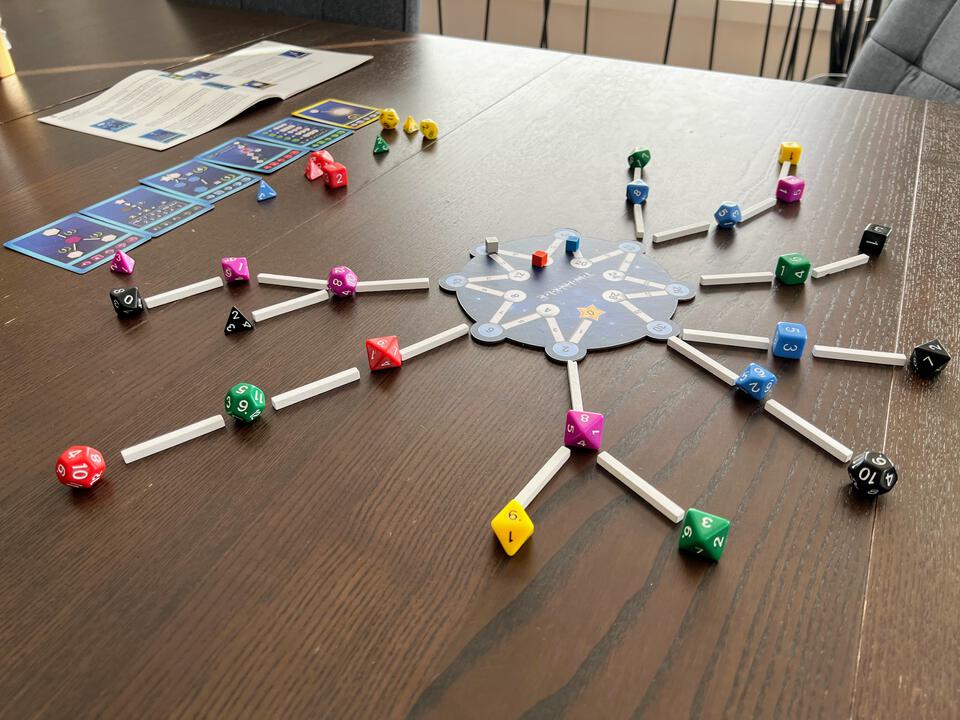
I had a classically Spiel experience trying out Twinkle. I sat down at an empty table, and the group that joined me was an older family of locals that spoke fairly little English. Meanwhile, the booth worker explaining the game didn’t speak German. We tried to learn the game together, hampered by the fact that most of the overlap in our vocabulary was numbers (good for a dice game! But not quite sufficient). We eventually made it through the game, although it took us much longer than the rated time.
It was a little hard to tell whether the rough patches on the game were due to linguistic challenges or the game itself, but now that I’ve tried it with an all-English-speaking crowd, I can definitely confirm that the game is a little rough. The scoring mechanisms are difficult to explain and internalize, which makes teaching the game difficult (even though the rest of the rules are straightforward). It’s not helped by weak English translations. And the production quality on the copy I received was definitely disappointing—some of the dice weren’t well-polished, and some of the sides were over-filed. I think the game mostly works with slightly less-than-fair dice, but I wouldn’t use these dice anywhere I cared about fairness!
The game does do one thing that I think is brilliant: during the game, the cardboard panel in the middle of the table has artwork showing you where you can build your constellations. After the placement ends, it flips over to reveal a scoring tracker. I love that the scoring tracker is hidden until you need it, rather than being an extra component. It’s a great judicious use of space.
I’m still forming a full opinion on how good of a game I think this is, but I do think it will play well with people who know the rules, and it has some strategic depth as you better understand the scoring and start playing more intentionally. It may or may not have a permanent place in my collection, but I’m excited to try it out a few more times before I make that call.
💸 Under Falling Skies
Under Falling Skies is basically Space Invaders: The Board Game. Technically, it wasn’t a new release at Spiel this year, since it came out last year, so it didn’t come up on my pre-Spiel list of games. But I was drawn to it by the giant version that Czech Games Edition set up at their booth, complete with huge foam dice and 3D printed alien spaceships:
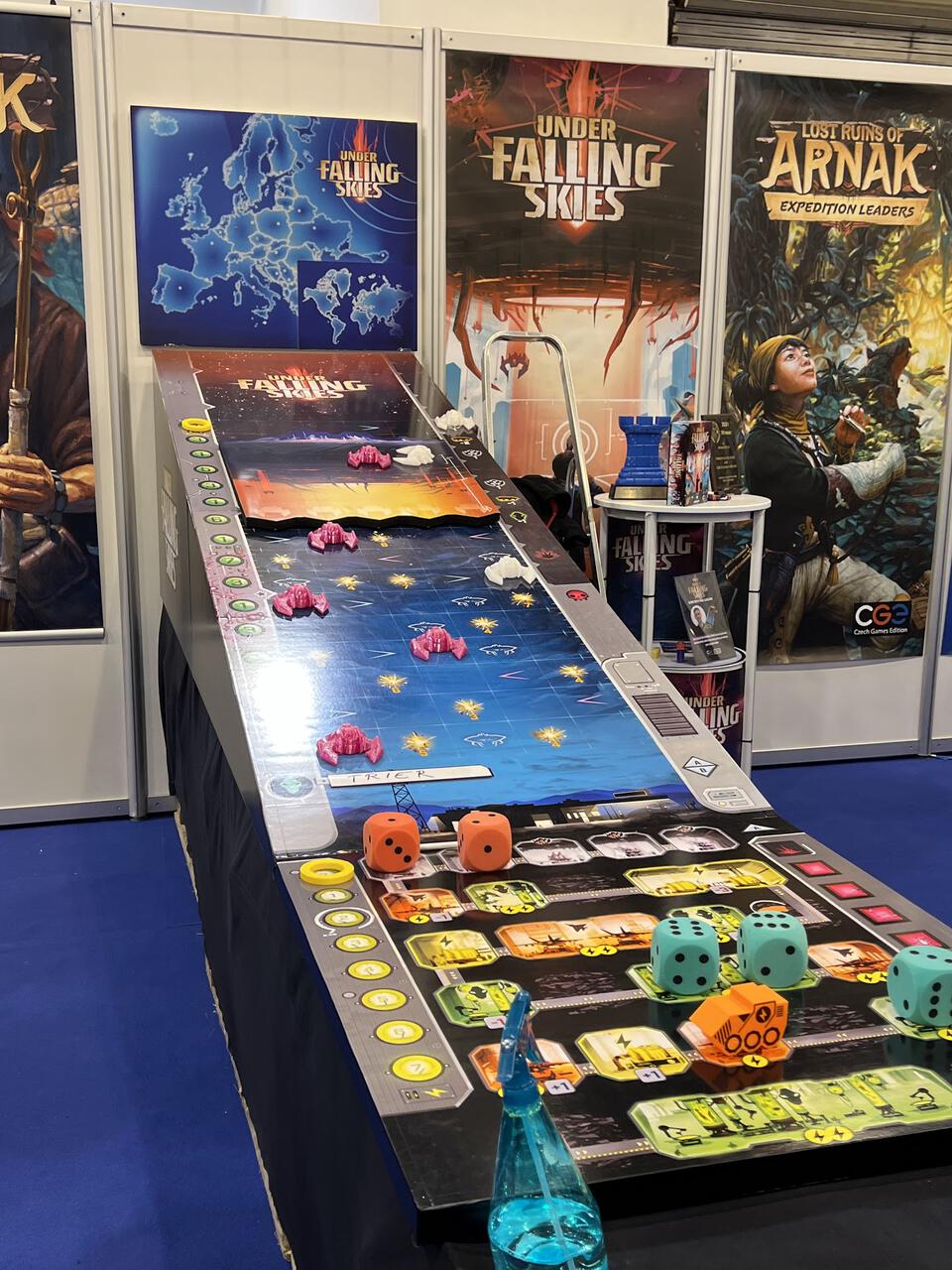
Under Falling Skies is a single-player board game (or maybe a single-team board game). In a game, you have to fight off the alien invasion for long enough that you can complete your research on the aliens. What are you researching? Not really clear, or that important. To fight off the aliens, you roll dice and place them in rooms in your underground bunker. You can only place one die in each column, and every time you place a die, the alien fighters in that column move down by the value on the die. This makes a fun puzzle where you’re trying to accomplish things, but everything you accomplish also advances the aliens.
In addition to the basic game, it also comes with a campaign mode, which gives you different cities to defend (with special abilities), different rooms in your bunker, and various special rules.
At Spiel, their giant version of the game was set on the second-easiest difficulty level (out of four). I came close to winning but lost on the last turn. I thought the game was challenging but fun. I’m always intrigued by the idea of single-player games for times when you can’t find other people to play with. And the quality of the components and the artwork is really high; it’s very satisfying to interact with.
💸 Welcome to the Moon
Welcome to the Moon is the latest game in the “Welcome To” series, starting in 2018 with a game called either “Welcome to Your Perfect Home” or just “Welcome To…” depending on what source you check. Welcome To came out at the height of the roll-and-write craze, and was generally quite well received. The core mechanic of the Welcome To series is “flip and write.” You have three stacks of two-sided cards, and every round you flip over one card from each stack; the face-up and face-down card from a stack form a pair. Each player chooses one of those pairs and writes it somewhere on their board with one key constraint: the numbers you write in a given row on your board must be in strictly ascending order. (You’re allowed to leave gaps and fill them in later)
In the original Welcome To, those rows are houses in a new development and you’re giving them house numbers. In the second game of the series, Welcome to Las Vegas, it’s casinos. In Welcome to the Moon, there are eight different scenarios, each with different rules and structures. The game has a continuing storyline where you try to escape a dying planet Earth and colonize space. So far, I’ve only played the first of the eight scenarios in Welcome to the Moon. In this scenario, you’re trying to get your rocket ship to take off before everyone else. It seems pretty clearly like an intentionally simple scenario, designed to teach you the basic mechanics of the game.
I found it enjoyable! It is relatively easy to teach and snappy to play. It does have a light “take that” element that isn’t present in the original game, which does limit the player count. (The original game advertises “1-100” players since without any player interaction the game can scale arbitrarily; Welcome to the Moon tops out at 6.)
I’m a little embarrassed to admit I’ve never played the original Welcome To, and this edition makes me enthusiastic to try. But for now, I’m having fun playing Welcome to the Moon, and I’m looking forward to trying the other rounds of the game as well.
💸 Whirling Witchcraft
So I spent the entirety of this post trying to approach games from an even keel, not pick favorites, and identify why someone might like a game, even if it’s not me. But now that we’re at the end of the alphabetical list, I have to admit: I think Whirling Witchcraft might be my favorite from Spiel this year.
In Whirling Witchcraft, each player is casting spells and using those spells to convert components. Each color of wooden cube represents a different component. On your turn, you cast one spell and then activate all (or as many as you can) of your spells, using ingredients on your board as inputs. You then take all of the cubes you generate, put them in your cauldron, and pass the cauldron to the next player. That player has to place all of the cubes they receive on their board. If they can’t, you win victory points.
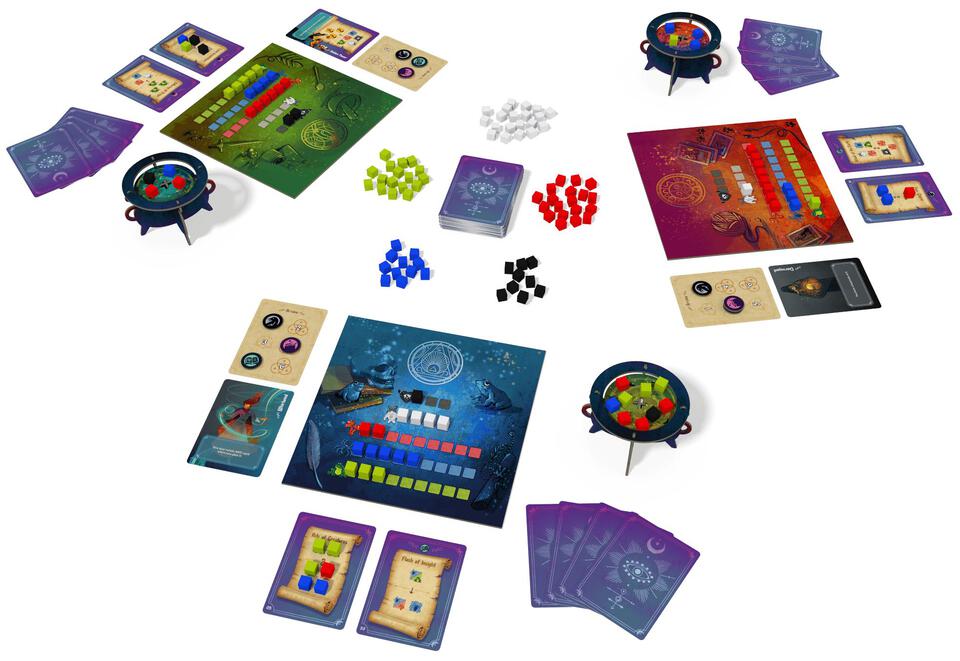
Photo by W. Eric Martin.
The end result is a game that’s an engine-builder, but one where you’re not in control of your inputs. You have to figure out how to take the ingredients your neighbor is feeding you and turn them into something that your other neighbor can’t handle, while your input-neighbor is trying to do the same to you.
I didn’t feel like any of the games this year were perfect, and this game is no exception. The game doesn’t handle imbalance of skill very well—if all but one player knows the rules well, the player feeding them ingredients will win. There’s also an “arcana” mechanism, where spells earn you points that turn into special powers. The arcana powers are weird and fiddly and hard to remember. Whenever I encounter a mechanism in a board game that’s weird and fiddly and hard to remember, I assume that it’s to mitigate some runaway imbalance in the gameplay that I just haven’t figured out. I still don’t know what the arcana are for, and I might prefer just playing without them.
But despite those issues, I like this game a lot. It’s relatively easy to teach (other than the arcana), plays quickly, and has an unusual mechanic that you don’t see often. While it isn’t an exorbitant production (it’s cards, cardboard punchouts, and wooden cubes), it’s well-produced with pleasant artwork and satisfying gameplay.
And there you have it—my reviews of the 19 games I bought or played at Spiel this year. If you’re looking at some of these new releases, hopefully, this will give you a bit more of a sense of what these games are like. And, of course, if you think I’m completely wrong, that’s OK! We don’t have to agree, but I’d certainly like to hear about other takes.
Happy Thanksgiving, and happy board gaming!